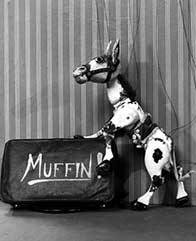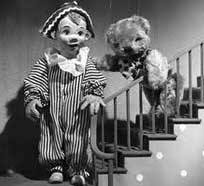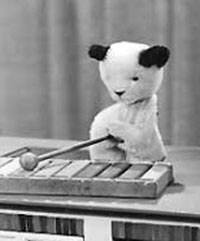
History
Others
Puppets

In 1946 a new superstar emerged onto the small screen. Described by The Daily Express as 'the biggest personality in TV', and oozing screen charisma, Muffin the Mule trotted onto television. Muffin, a string marionette, danced energetically on top of a piano, while Annette Mills played the music and acted as co-star to this new puppet heavyweight. The fifteen minute long children's show revolved around normal everyday situations, such as Muffin's bath day. He was a great success and ran on television until 1955. Just one week after Muffin's retirement from acting, Annette Mills died after an operation at the age of 61. Muffin the Mule was a major part of the popular culture of the 1950s. The Observer newspaper wrote in 1949, 'when a puppet like Muffin the Mule is on view I realise that television is one of the pictorial arts as well as a medium of instantaneous communication.' Not bad for a small wooden horse.
Muffin had various puppet sidekicks, but it was not until four years after his debut that the BBC came up with another immortal symbol. In 1950, Watch With Mother was lunched onto the airwaves. Although the BBC had been making Muffin the Mule since 1946, their shows were aimed at children generally. Watch Wirth Mother was the first attempt to aim a series of shows at the pre-school child. The first programme to be included was the blue stripped suited marionette Andy Pandy.
Andy Pandy was created by Maria Bird and Freda Lingstrom (Freda later became the head of children's television at the BBC). Their aim was to provide a 'friend' on the screen for the young viewer to relate to. As a child actor of three years old was impossible, a puppet built to the same proportions was the obvious choice. Originally a solo performer, Andy was soon joined by two more puppets - a bear called Teddy and Looby Loo the ragdoll. The trio lived in a large basket, to which they returned at the end of the show. As with Muffin the Mule, the tales were simple, with no overall theme becoming apparent. All three puppets were mute, with the story unfolding by narration. As with all marionettes of this period, the strings were thick and intrusive. The children didn't mind though, and were delighted. The end song 'Time to go home, time to go home, Andy is waving goodbye, goodbye' has embedded itself within the memories of generations.
Two years after Andy's television premiere, another masterpiece was unveiled. Children saw in 1952 what really goes on in the gardener's potting shed when humans are not around. During this period, Bill and Ben The Flowerpot Men come out to play. This time the marionettes did talk, albeit in an unintelligible language. Their odd conversations of 'flibadob, flobadob' sparked controversy when parents complained that their little one's speech was being impaired. Again the children didn't care, and the show became well loved. Both Andy Pandy and The Flowerpot Men were repeated on our screens for almost two decades.
Many other puppets emerged during the early years of television, mostly marionettes, but one glove puppet was to outlive all opposition. Indeed, he has the honour of being the star of the longest running children's show on British television. On Talent Night in 1952, human co-star Harry Corbett appeared with a small, mute, orange little bear simply named Teddy. The naughty bear was an instant success. Shortly after Talent Night's transmission, The Sunday Express raved 'Five minutes on the television screen last night established Harry Corbett's teddy bear as rival to Muffin the Mule.' When Harry Corbett blacked out Teddy's ears with soot, a new name was given to the loveable little bear - Sooty. He was soon given his own series, The Sooty Show, entertaining generations of juniors. Unlike the majority of puppets at the time, this bear was always up to mischief. Often he would torment Harry, squirting his water pistol at anybody and everybody. Children viewed his antics with enjoyment and delight, their hero engaging in many things they wished they could do themselves. Puppet co-stars Sweep and Soo, soon joined Sooty in his capers. The Sooty Show was axed by the short-sighted BBC in 1967, but found a new lease of life on independent television. However, the show has not had a trouble free run. The Sooty Show was accused of drug pushing when Sweep was pushed into a tranquillising booth, and involved in sex scandal when Soo pretended to be pregnant. The press, wanting a smutty angle on children's television omitted the word 'pretended', and put out front page headlines that Soo was pregnant. But through it all, the children were glued to their television sets, and the show flourished. A version of Sooty is still on the airwaves today.
There are probably several reasons for the naughty little bear's success. In today's television, the marionette puppet has all but disappeared. This is a complete turnaround from the 1950s, when almost all puppets were marionettes. In our modern society, the string puppet can look old fashioned and outdated. The Sooty Show started off as a simple programme - one glove puppet controlled by his human co-star. As it continued over the years it has become more complicated. Aside from Sooty, there have been a number of different co-stars, both puppet and human, together with moving cars and props. Far more complex than the original, but still easier, less time consuming, and therefore often cheaper than strings. Due to its appeal to the youngsters and its comparative cheapness, it can easily be seen why Sooty has survived, whilst others have been left in the midst of time.
The emergence of puppets as children's TV was an obvious step. Children's programmes were not of a high priority for the fledgling BBC. Puppets at the time were fairly cheap to buy or make. Muffin the Mule was bought for 15s 0d, and Sooty cost just 7s 6d. Put together with one human presenter or narrator, and the outcome was a low cost but effective children's programme. Added to this, is the puppet's resemblance to a toy. An instant rapport could be forged between the child and the toy-like puppet. The fact that the toy moved by itself and had human characteristics aided in the disbelief of reality. To the children of the 1950s it did not matter that the strings were visible, or that it was in black and white. Indeed, any technological problems were not important. Here were toys and creatures, shown before them in the safety of their own homes that must surely exist in reality as beings in their own right. As many adults today who watched Muffin the Mule would now be in their retirement, it's hardly surprising that the puppets they grew up with as a child would help to peddle the view that the puppet is kiddie's entertainment. It is children's television that introduces the majority of people to puppets after all.
Watching With Mother
The Sooty Show(Left)
Andy Pandy & Teddy (Above)
Muffin the Mule (Right)





This website is the copyright of Benjamin Burford-Jones 2014, except quotations and photographs used to illustrate various traditional and television puppets.
No material should be reproduced in any form whatsoever for purposes of commercial gain without obtaining the copyright holder’s express permission.
Herb the Owl | Alex the Droog | What is a Puppet | Watching With Mother | Gerry Anderson | Jim Hensons Muppets
From Satire to Sitcom | Are Puppets Just for Kids | About the Author and Links















